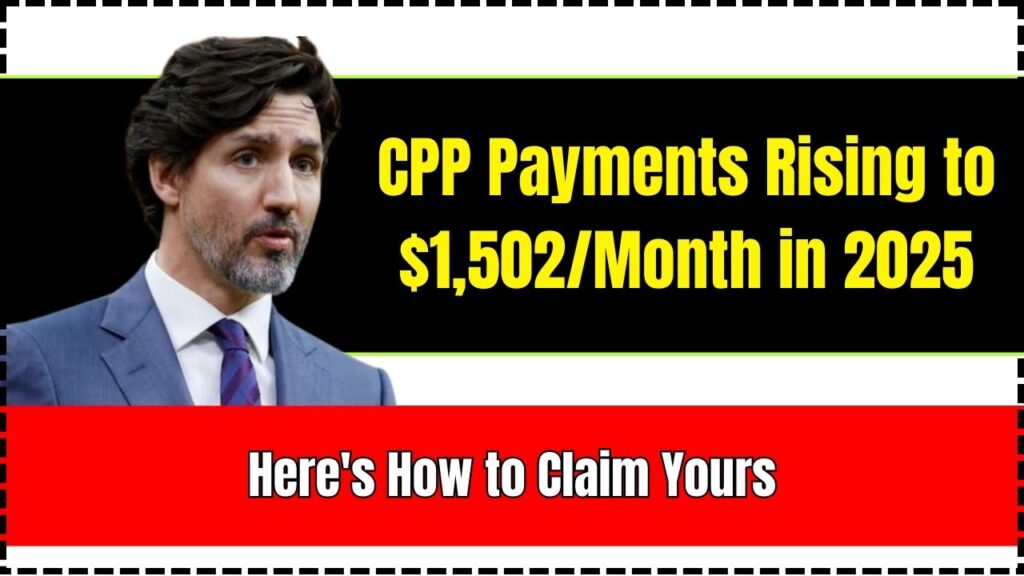CPP Payments Rising to $1,502/Month in 2025: As we move into 2025, there’s good news for Canadians preparing for retirement. Canada Pension Plan (CPP) payments are increasing to $1,502 per month, marking a significant milestone in retirement planning. This boost in pension income is a result of ongoing efforts by the federal government to improve retirement security for Canadians of all income levels. Whether you’re nearing retirement age or just starting to think about your future, understanding how the CPP works—and how to claim your benefits effectively—is more important than ever.

This comprehensive guide is designed to help you navigate the Canada Pension Plan with ease. Whether you’re 30 years from retirement or planning to apply this year, we’ll cover everything you need to know, including how to qualify, how to apply, when to apply, and how to strategically increase your monthly payments. We’ll also provide valuable tips, real-world examples, and links to official resources so you can take action with confidence.
CPP Payments Rising to $1,502/Month in 2025
| Topic | Details |
|---|---|
| Maximum CPP Payment (2025) | $1,502/month |
| Minimum Age to Apply | 60 (with reduced benefits) |
| Full Benefits Age | 65 |
| Delayed Retirement Bonus | Up to 42% increase if you delay until 70 |
| CPP + OAS Combined (75+) | Up to $2,377/month |
| Official Source | canada.ca |
With CPP payments rising to $1,502/month in 2025, this is a prime opportunity for Canadians to reassess their retirement plans. Whether you’re approaching retirement or just getting started with your savings, knowing how the Canada Pension Plan works—and how to make the most of it—is essential for a secure financial future.
Take the time to understand your options, explore the tools available on canada.ca, and consider consulting a financial planner. The choices you make today can have a lasting impact on your quality of life during retirement.
What Is the Canada Pension Plan (CPP)?
The Canada Pension Plan (CPP) is a public retirement pension program administered by the federal government. It was created to provide a basic income for Canadians after they stop working due to age or disability. Contributions to CPP are made through payroll deductions by both employees and employers, or by self-employed individuals who pay both shares.
In practical terms, CPP acts like a personal savings plan managed by the government. As you work and earn income, you and your employer make regular contributions to your CPP account. These contributions build up your eligibility for future retirement payments. When you retire, those contributions turn into a steady monthly income.
Your CPP retirement pension is based on three main factors:
- How long you’ve worked
- How much you earned during those years
- When you choose to start collecting your pension
The longer you contribute and the more you earn, the higher your retirement benefit will be.
Why Are CPP Payments Increasing in 2025?
The increase to $1,502/month is part of a broader plan known as the CPP Enhancement Plan, which was initiated in 2019 and is being rolled out gradually over several years. This plan aims to give future retirees a larger monthly income by expanding the earnings covered under CPP and increasing the percentage of income it replaces.
Key Reasons for the Increase:
- Indexation to Inflation: CPP benefits are adjusted annually to keep up with the cost of living. This ensures that your retirement income maintains its purchasing power.
- Higher Contribution Rates: Workers and employers have been contributing slightly more each year since 2019 to fund the enhanced benefits.
- Expanded Replacement Rate: Previously, CPP replaced about 25% of your average annual earnings. Under the enhancement, it will now replace up to 33.33%.
- Elevated Contribution Ceiling: The maximum earnings level on which CPP is calculated is increasing, allowing higher earners to contribute and receive more.
According to the Government of Canada, this enhanced system is designed to be sustainable, equitable, and effective for both current and future generations.
How to Claim Your CPP Payments
Unlike some other government benefits, you won’t automatically receive CPP when you hit a certain age. You have to apply. Here’s how to do it:
Step 1: Check Your Eligibility
You are eligible to apply if:
- You are at least 60 years old.
- You have made at least one valid contribution to the CPP (whether through employment or self-employment).
Step 2: Decide When to Start Receiving CPP
The age you start collecting CPP greatly affects your monthly payment.
- Age 60: You can start as early as 60, but your payment will be reduced by 0.6% for each month before your 65th birthday (a total reduction of up to 36%).
- Age 65: You receive the standard amount.
- Age 70: If you wait, your monthly benefit increases by 0.7% per month delayed after age 65, up to a 42% increase.
Step 3: Submit Your Application
- Online: Use your My Service Canada Account for a fast, secure process.
- Paper Form: You can download the application form and mail it in.
Be sure to apply six months before you want your payments to begin to avoid delays.
Step 4: Monitor the Status of Your Application
Once submitted, Service Canada usually processes applications within 7 to 14 weeks. Use your online account to check progress, update details, or view correspondence.
Maximizing Your CPP Payments
Timing and strategy can make a substantial difference in your CPP income. Here are some actionable ways to boost your monthly pension:
1. Postpone the Start of Your Pension
Waiting until age 70 can boost your CPP payments by as much as 42%. This is ideal if you are in good health and have other income sources.
2. Continue Working Past 65
Working beyond age 65 allows you to continue making CPP contributions, which could further increase your benefits through the Post-Retirement Benefit (PRB).
3. Request a Statement of Contributions
Access your CPP Statement of Contributions through your online Service Canada account. This record shows how much you’ve contributed and offers a glimpse of your estimated benefits.
4. Pension Sharing with a Spouse
Couples can split CPP income to reduce their tax burden. This is especially helpful if one spouse earned significantly more than the other.
5. Use Dropout Provisions
CPP allows for certain low-income years (such as during unemployment or while raising children) to be dropped from your average earnings calculation, which can increase your final benefit.
Understanding CPP vs. OAS: What’s the Difference?
Many people confuse CPP with Old Age Security (OAS), but they are separate programs.
- CPP: Based on how much and how long you contributed during your working years. You must have worked in Canada.
- OAS: A non-contributory benefit funded by tax revenues, based on how long you’ve lived in Canada after age 18.
OAS Benefit Rates in 2025
- Ages 65 to 74: Up to $800.44/month
- Ages 75 and older: Up to $875.93/month
You can qualify for both CPP and OAS. If you qualify for the full amounts of each, your total monthly retirement income could reach approximately $2,377.
Claim Your $500 Canada Housing Benefit – April 2025 Eligibility Criteria and Application Process!
Canada Offers $1,700 CPP Payments to Seniors in 2025 – Check Eligibility Criteria and How to Claim!
2025 Brings Changes to Canada’s Tax System – How the CRA Updates Will Impact You?
Frequently Asked Questions (FAQs)
1. Can I work while collecting CPP?
Yes. You can work while receiving CPP. If you’re under 70, you can continue contributing and earn extra through the Post-Retirement Benefit.
2. Is CPP income taxable?
Yes. Like other forms of income, CPP payments are taxable and should be reported on your annual tax return.
3. Can I collect CPP if I live outside Canada?
Yes, you can. As long as you paid into CPP while working in Canada, you can receive benefits regardless of where you live.
4. Are retroactive payments available if I apply late?
CPP allows retroactive payments of up to 12 months. For example, if you were eligible last year but apply this year, you can still receive backdated payments for the missed months.
5. What if I had low or no income for several years?
CPP has provisions to drop your lowest-earning years from the calculation, which helps maximize your monthly benefit.








